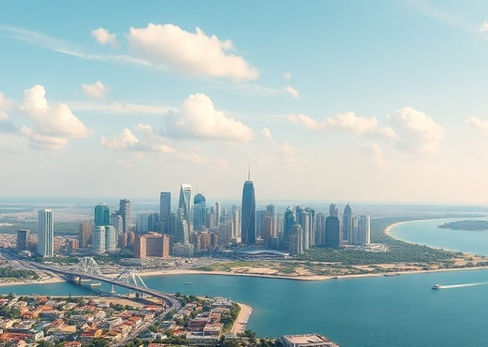The Struggles of Energy Access in Pampa Clemesí, Peru
- THE MAG POST

- Aug 10
- 6 min read

Energy access is a pressing issue in communities like Pampa Clemesí, Peru, where proximity to a massive solar facility doesn’t translate into power for its residents. Despite living next to one of the largest solar plants in Latin America, many people in this village struggle to connect to the energy grid. This gap illustrates the larger narrative of renewable energy: its potential for transformative change is often sidelined, leaving vulnerable populations in the dark, quite literally.
The issue of energy access remains a pervasive challenge, as vividly illustrated in Pampa Clemesí, Peru, where the proximity to one of the largest solar plants does not guarantee residents access to electricity. This paradox highlights the pressing need for sustainable energy solutions that reach the most vulnerable communities. Although the Rubí solar power plant produces enough power to sustain hundreds of thousands of homes, the village itself struggles to harness this energy. Remarkably, Pampa Clemesí is situated in an ideal region for solar power utilization, yet its inhabitants remain disconnected from the national grid.
Energy Access: The Solar Paradox in Pampa Clemesí
Energy access is crucial for societal development, and this predicament presents a significant contradiction: despite being surrounded by a pioneering solar energy infrastructure, most villagers in Pampa Clemesí find themselves deprived of electricity. This community, which consists of around 150 residents, contends with the paradox of living adjacent to a solar power plant yet remains without electric power in their homes. The situation raises serious questions about the broader energy infrastructure and its considerations for rural populations.
The Rubí solar plant produces approximately 440 GWh of energy annually, sufficient to power about 351,000 households. However, the dilemma arises as most households, including Rosa's, lack the financial resources to benefit from solar installations or battery systems necessary to utilize solar energy effectively. This financial barrier inevitably exacerbates the struggle for basic needs, making the situation dire for Pampa Clemesí residents.
In an area that enjoys over 3,200 hours of sunshine annually, it’s astonishing that local families are in the shadow of a renewable energy boom while facing continued challenges with electricity access. As Peru ramps up its reliance on renewable sources, generating nearly a 100% increase in electricity from renewables by 2024, villages like Pampa Clemesí highlight a stark reality where the benefits of solar power are not equally distributed across society.
As the energy expert Carlos Gordillo points out, Peru’s energy system prioritizes profitability over accessibility, leaving remote and sparsely populated areas disconnected from modern conveniences. The challenge therefore lies in the commitment to inclusive energy policies that are designed to electrical empower all communities, ensuring that no one is left behind should a renewable energy revolution become a reality.
Challenges of Disconnect: The Reality in Pampa Clemesí
Life in Pampa Clemesí represents a stark contrast to the modern conveniences enjoyed elsewhere in the country. The community’s struggle for basic electricity access speaks volumes about the systemic issues that plague energy distribution in the rural parts of Peru. Without proper connections to the power grid, nighttime falls into darkness, and the inhabitants resort to makeshift solutions. Some residents depend on solar-powered torches, illuminating their lives sporadically while enhancing the sense of isolation from the neighboring solar power plant.
Efforts have been made by Orygen, the operator of the Rubí solar plant, in tandem with government projects to bring electricity to the community, completing infrastructure investments like power towers and underground cables. However, the lingering question is how the local and national partnerships will evolve to ultimately connect individual homes to the growing energy network. The final touch of connecting these homes remains in the hands of government entities, tragically delaying any hopes for progress.
Community members are challenged by the absence of adequate services like water, sewage systems, or waste management, making life even more difficult. Many families have already left due to the lack of necessary infrastructure. The COVID-19 pandemic emphasized these issues, leading to further migration in search of better living conditions. Stories like that of Pedro Chará, a 70-year-old resident, underline the human aspect behind the struggle for resources and reveal the emotional burden carried by those left behind.
Moreover, the physical struggle to acquire necessities is compounded by a lack of basic connections to communal and social infrastructure. Residents find themselves dependent on small-scale interactions and communal efforts. Local leaders often step forward to devise strategies to address urgent needs, emphasizing the importance of community resilience even amidst these challenges. As individuals share resources, such as charging electronics at each other's homes, the social dynamics of survival become increasingly interlinked.
Health and Environmental Impacts: A Broader Perspective
The absence of electricity leads to detrimental effects on health and well-being in Pampa Clemesí, particularly when it comes to cooking methods. Many households rely on firewood for cooking, which pose health risks, including respiratory illnesses, due to smoke inhalation. This aspect of energy poverty underscores the multifaceted nature of difficulties faced by residents. Sustainable and clean energy access could significantly improve their quality of life by eliminating harmful practices.
The reliance on traditional fuels further highlights environmental concerns, as families often resort to kerosene or wood, risky practices that yield negative health outcomes. The bright prospect of light and health through proper energy access is overshadowed by the grim realities of scarcity, especially as the community strives for more sustainable cooking methods. There's an evident need for interventions that not only provide electricity but also promote healthier living standards.
Furthermore, the struggle for solar access carries implications for educational opportunities. Without power, young students can't use modern technologies or study effectively at night. The educational gap widens as families remain trapped in an energy-deficient cycle, further capping future possibilities. Ensuring that the youth in these communities receive a proper education is possible through reliable energy access, paving paths for improved quality of life.
While the current initiatives promise some hope, it’s crucial to establish a holistic approach to renewable energy that’s equitable and inclusive. The move towards greener and more sustainable practices cannot be just a slogan; it should be a lived reality for communities like Pampa Clemesí. Sustainable energy access is integral in building stronger societal structures that enhance public health and environmental well-being.
Hopes for the Future of Energy in Pampa Clemesí
The future of energy access in Pampa Clemesí hinges on collaborative efforts among local communities, energy developers, and governmental agencies. As investments and projects continue to shape current energy landscapes, the inclusion of marginalized areas must come to the forefront. The landscape of energy access should not be defined by proximity to resources but rather by improved policies and committed implementations that pave the way for sustainable living.
In light of the story of Rosa and her neighbors, it becomes apparent that hope is a vital component of the human spirit. Rosa beautifully states, "Here, we always have the sun," reflecting the persistent hope and resilience within her community. This statement beautifully encapsulates the duality of their situation—living in daylight but remaining in darkness at night. This hope needs to be transformed into action to foster lasting change.
Community leaders like Marco Fragale also show commitment to revamping infrastructure projects, indicating positive momentum. However, persistence is essential, and continuous pressure on authorities will be necessary to ensure actual implementation. The pressing need for light in homes should resonate with decision-makers and promote a faster timeline for actions, particularly to connect the remaining homes to the national grid.
As more residents join in advocating for better energy solutions, it’s essential to amplify their voices. Ensuring that the stories from Pampa Clemesí reach broader platforms may inspire proactive measures addressing energy disparities within Peru. Public support and awareness are paramount to shifting paradigms toward inclusive energy access.
Ultimately, achieving energy justice in Pampa Clemesí isn’t just an environmental issue; it’s a human right. Harnessing the abundant solar power through equitable means can revitalize communities and improve lives, leading to a future where everyone can genuinely enjoy the benefits of renewable energy.
From our network :






















































Comments